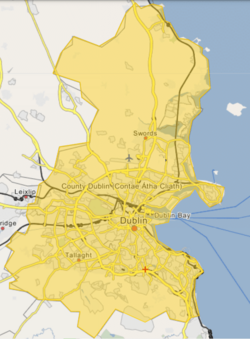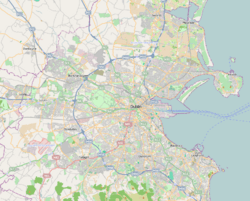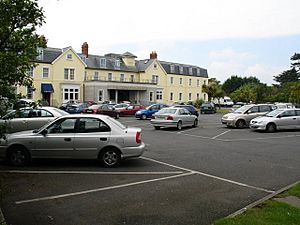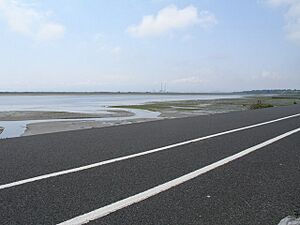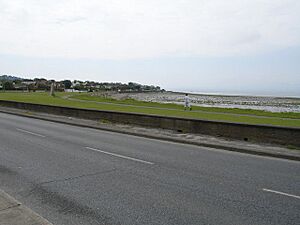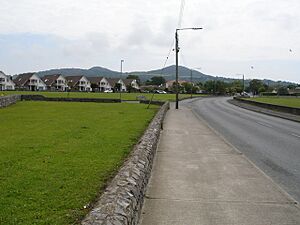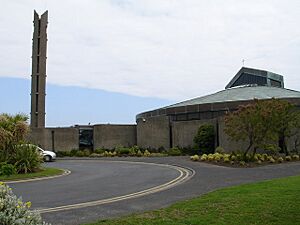Sutton, Dublin facts for kids
Quick facts for kids
Sutton
Irish: Cill Fhionntain
|
|
|---|---|
|
Suburb
|
|
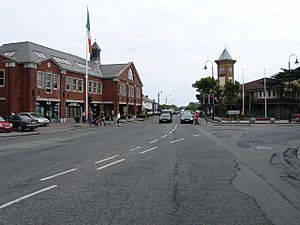
Sutton Cross
|
|
| Country | Ireland |
| Province | Leinster |
| County | Dublin |
| Administrative County | Fingal |
| Population
(2016)
|
|
| • Total | 5,680 |
Sutton (which means "Fintan's cell or church" in Irish) is a lively neighbourhood located on the north side of Dublin, Ireland. It sits on a narrow strip of land called a tombolo. This tombolo connects Howth Head to the main part of Ireland. Sutton also includes some lower parts of Howth Hill and nearby coastal areas.
The area is managed by Fingal County Council. At the heart of Sutton, where several roads meet, you'll find a small area with shops and businesses. Sutton is part of the old Barony of Coolock in what was traditionally County Dublin.
Contents
History of Sutton
The first time Sutton was mentioned in official records was between 1228 and 1248. This mention was found in a historical document called the Calendar of Archbishop Alen's Register. It's thought that the name Sutton might come from a person of Norman background.
Where is Sutton Located?
Historically, Sutton was mainly on the Howth peninsula. This included areas from Sutton Cross up to Claremont Road and where Barren Hill meets Carrickbrack Road. It also included the Martello Tower at Red Rock.
Today, Sutton is thought to stretch further. It reaches the railway line where it meets Baldoyle. It also extends to the junction of Baldoyle Road and the coast road, where it meets Bayside. These extra areas used to be farmland. The only nearby area on Howth Head is Howth itself.
How to Get Around Sutton
Sutton is about 12 kilometres from Dublin city centre. It is located on the Howth Road (R105). Sutton is close to Howth, Baldoyle, and Bayside.
- Bus Services: Dublin Bus routes H3 and 6 serve the area. These are part of the BusConnects system.
- Cycleways: There is a cycle path that links Sutton to Clontarf and Fairview. Work is still happening to connect it all the way to Sandymount.
- Train Station: Sutton railway station opened on July 30, 1846. It was first called Baldoyle & Sutton but changed to Sutton in 1901. This station is on the Howth branch of the train network. It is served by the Dublin Area Rapid Transit (DART) system, which is a fast commuter train.
- Old Tramway: The Hill of Howth Tramway used to run between Sutton railway station and Howth railway station. It went around the Hill of Howth until 1959.
Sutton's Natural Features
Sutton's main feature is a tombolo. This is a natural land bridge that connects Howth (which used to be an island) to the mainland. The original village of Sutton was on the side of Howth Head facing the city. It was along Strand Road, where you can still see old houses and a small harbour. However, the centre of Sutton is now around Sutton Cross.
Streams in Sutton
There are a few small streams in Sutton. Most of them flow underground through pipes. Some tiny streams cross the Cliff Walk paths near Sutton. Two larger streams, the Santa Sabina Stream and the Carrickbrack Stream, flow into the sea at Sutton Strand.
- The Carrickbrack Stream starts near Howth Golf Course. It flows roughly next to Carrickbrack Road and reaches the shore at the south-western end of the beach.
- The Santa Sabina Stream comes from the Howth (Deer Park) Estate. It flows underground past the Offington housing estate and through the grounds of Santa Sabina Dominican Convent. It reaches the sand about 150 metres north of the Carrickbrack Stream's mouth.
Beaches in Sutton

Sutton is surrounded by many beautiful beaches. The Burrow Beach is very popular with both local people and visitors. It is about 1.2 kilometres long. It stretches from Sutton Golf Club to Howth, along one side of the tombolo. Sutton Strand runs along the coast road and in front of St. Fintan's church.
Old Quarries
Two quarries used to operate in Sutton. One was on the Howth Road near Corr Castle, and the other was at Barren Hill on St. Fintans Road. Both of these quarries are now closed.
Shops and Services in Sutton
Sutton has one main area for shops and services. Here you will find a Supervalu supermarket. This store used to be a Superquinn and is located under that chain's main office. Before that, it was a local cinema.
You can also find the Marine Hotel, a post office, and other banks, restaurants, and shops. The local petrol stations closed a few years ago. Now, the closest places to get fuel are in Kilbarrack and on Baldoyle Road.
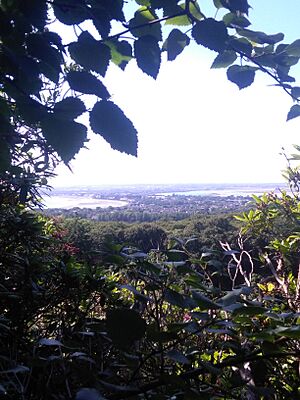
Sports and Fun Activities
Sutton offers many ways to stay active and have fun:
- Sailing: You can go dinghy sailing off the coast at Sutton Dinghy Club, which is located in Sutton Creek.
- Golf: Golf can be played at Sutton Golf Club. There are also golf facilities at Howth and Deerpark nearby. Deerpark also offers footgolf and poc fada (a traditional Irish sport).
- Rugby: Suttonians Rugby Football Club is on Station Road. It's a great place for local rugby players and fans.
- Tennis and Squash: Sutton Tennis Club has 12 outdoor tennis courts and five indoor squash courts. It is the biggest club for junior squash in Ireland.
- Soccer: The local soccer club is Howth Celtic. Their grounds are across from St. Fintan's primary school on Carrickbrack Road.
- Scouting: There is a local scout group that meets in St. Mary's Church of Ireland Parish Hall in Howth.
- Walking Trails: Red Rock is the starting point for the Cliff Walk. This walk covers a large part of Howth Head and finishes in Howth village. Shielmartin Hill is also easy to reach from Sutton.
Important Buildings in Sutton
- Corr Castle: One of the oldest buildings in the area is the 15th-century Corr Castle. It's located in Sutton North, near the Howth Road entrance to the Offington housing estate. This castle was once part of the Howth Park Racecourse.
- Martello Tower: Sutton is home to one of Ireland's Martello Towers at Red Rock. These towers were built to defend the coast. This particular tower is now a private home.
- Sutton Castle: Also in Red Rock is Sutton Castle. This grand building used to be the home of the famous Jameson family. Later, it became a hotel called Sutton House Hotel and then Sutton Castle Hotel. In 2003, it was changed into private homes.
- Georgian Houses: Several beautiful Georgian-era houses are in Sutton. These include Beachfield House (once called Devonshire Terrace) and Sealawn House (built in the 1830s). Sealawn House was owned by John Pentland Mahaffy, a famous scholar. Next to these houses is a row of cottages made of Howth stone, called Martello Terrace. The last house in this row used to be the old Sutton coast guard station, but it is now a home.
- Old Tram Shed: The old shed used by the Hill of Howth Tramway is near Sutton Station. It has been turned into a private home as part of a new housing development.
- Luí na Gréine: The Luí na Gréine (which means Sunset in English) is a granite standing stone monument. It is located on the pathway along Sutton strand. It was designed by Cliodhna Cussen and put in place in the mid-2000s.
Schools in Sutton
Sutton has several schools for children of different ages:
- Primary Schools:
- The Burrow School (mixed) on Dublin Road.
- St. Fintan's National School (mixed) on Carrickbrack Road.
- The primary part of Sutton Park School (mixed).
- Secondary Schools:
- St. Fintan's High School (boys' school, technically in Baldoyle).
- Santa Sabina Dominican College (girls' school), also known as Santa Sabina.
- The senior part of Sutton Park School (mixed).
Places of Worship
Sutton has its own Roman Catholic parish, St. Fintans. The parish church is located at the bottom of Howth Hill, next to Santa Sabina School.
There is also a Methodist church at the corner of Church Road and Howth Road.
Sutton is home to one of Dublin's main burial grounds, St. Fintan's. This cemetery is split into two parts: an "old" section and a "new" section. The old part has a ruined chapel from early Norman times.
Uphill from the older graveyard, you can find the still-flowing holy well of St. Fintan. It is located in a wooden hut on private land.
How Sutton is Governed
Sutton is part of the Dublin Bay North area for Dáil Éireann (Ireland's main parliament). Before this, it was part of Dublin North-East.
The area is also within the Howth-Malahide local electoral area. This is part of the Fingal County Council's area. There is also a specific electoral division called Sutton.
Famous People from Sutton
Many interesting people have lived in or are connected to Sutton:
- Bernard "Bunny" Carr: A well-known radio announcer, TV host, and founder of Carr Communications.
- Ian Dempsey: A popular radio and television presenter.
- Jim Fitzpatrick: An artist famous for his Celtic-style work and the iconic two-tone portrait of Che Guevara. He lives on Burrow Road.
- Gerry Gannon: One of Ireland's biggest property developers.
- Kevin Grogan: A former youth player for Ireland and Manchester United.
- Sheelagh Harbison: An Irish historian who studied the Middle Ages.
- Patrick Hillery: A former President of Ireland, who lived in Sutton for many years.
- Aidan Kearney (rugby union): A former rugby player for Leinster and Ulster.
- Frank Kearns: The owner of Rockschool and founder of the Irish rock band Cactus World News.
- Ian Keatley: An Irish professional rugby player who played for Munster and Leinster.
- Alice Lawrenson: A 19th-century Irish gardener who lived at Sutton House (later Sutton Castle).
- Phil Lynott: The famous musician from the band Thin Lizzy. He lived with his family on Burrow Road in the 1980s and is buried in St. Fintan's Cemetery.
- Philomena Lynott: Phil Lynott's mother.
- John Pentland Mahaffy: Lived at Sea Lawn house on Shielmartin Road between 1886 and 1897.
- Larry Mullen, Jr.: The drummer for the famous rock band U2.
- Marie Perolz: An Irish nationalist and feminist.
- Vogue Williams: A well-known personality who was educated at Santa Sabina school.
Images for kids
-
Burrow Beach at Sutton, Dublin, looking north towards Lambay Island
-
Sutton as seen from Howth Head.


